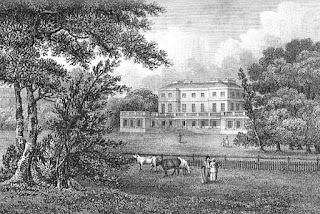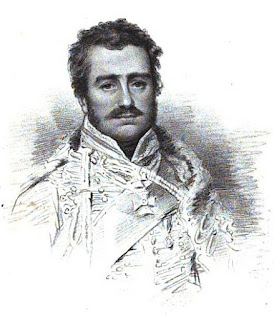 |
| Princess Elizabeth from The Lady's Magazine (1793) |
Princess Elizabeth (22 May 1770 - 10 January 1840) was the third daughter of King George III and Queen Charlotte. She was a gifted artist and married Prince Frederick of Hesse-Homburg at the age of 47.
Birth of Princess Elizabeth
Princess Elizabeth was born at Buckingham House on 22 May 1770, the seventh child of King George III and Queen Charlotte. She was christened by the Archbishop of Canterbury in the great council chamber at St James’ on 17 June.
 |
| The Queen's Palace (Buckingham House), from The Microcosm of London (1808-10) |
A restrictive upbringing
Elizabeth and her sisters received their education at home, under the auspices of Lady Charlotte Finch. They were taught English, modern foreign languages, geography, history, music, art and needlework. Elizabeth had excellent taste in music and was particularly gifted artistically, excelling in both design work and painting.
Read more about Princess Elizabeth - the artist.
The Princesses were allowed very little freedom; Queen Charlotte had to approve of every book that they read and every acquaintance that they made.
Visits and holidays
There was little variation in their routine except for the occasional outing or visit, such as in 1785, when Elizabeth was in the party that went to the Egham Races and to Oxford, and visited Lord and Lady Harcourt at Nuneham.
The royal family visited the seaside at Weymouth almost every year from 1789 to 1805 for the sake of the King’s health. Elizabeth also visited Bath with her mother in 1817, a visit which ended abruptly because of the death of Princess Charlotte.
 |
| Weymouth |
Elizabeth made her first appearance in the ball room at the King’s birthday celebrations in 1785, where she walked a minuet with Lord Rochford. Her dress was “the very counterpart of the Princess Royal’s”, suggesting that there was little scope for individuality.
An alarming incident
On 29 April 1788, Princess Elizabeth suffered an alarming incident. While she was sitting in her room, she was disturbed by the entrance of an unknown man, who must have climbed over the wall into the Queen’s garden. On the Princess alerting her attendants, the man was seized and forced to leave, but he returned a short while later to request an interview with the Princess so that he could pour out his love for her! The intruder was a hairdresser of the name of Spang who proved to be insane and was committed to Tothill Fields Bridewell.
Person and character
Elizabeth was very sensitive and emotional, but inclined to be rather managing. She suffered from poor health and became very overweight. As a result, her sisters nicknamed her Fatima.
 |
| Princess Elizabeth from A Biographical Memoir of Frederick, Duke of York and Albany by John Watkins (1827) |
The reluctant spinster
Elizabeth passionately desired to get married and have children of her own. Ever hopeful of becoming a bride, she drank sugar melted in water at night, supposedly to keep her temper sweet, and took long walks to prevent herself getting any fatter.
In the meantime, she kept herself occupied. She wrote her mother’s letters, collected porcelain and kept some Chinese pigs in a field at Frogmore. Unable to have her own children, she looked after other people’s children and devoted herself to charitable works for orphans.
 |
| Frogmore House from Memoirs of Her Late Majesty Queen Charlotte by WC Oulton (1819) |
There are unsubstantiated rumours that, as a young woman, Elizabeth had an affair with one of the King’s pages which resulted in an illegitimate child.
In 1808, the Duke of Orleans, the future French King Louis-Philippe, made her an offer which she desperately wanted to accept. However, the Queen was horrified at the proposed match because he was a penniless Roman Catholic.
 |
| King Louis Philippe of France from Life of Louis Philippe by SG Goodrich (1848) |
It was not until 1818 that Elizabeth received another offer of marriage, this time from Philip Augustus Frederick, Hereditary Prince of Hesse-Homburg, with whom she had been corresponding for two years. The Queen initially seemed resigned to the marriage, but when she realised that she would soon be deprived of her favourite daughter’s company, she became very difficult, causing Elizabeth considerable distress. Eventually, the Queen withdrew her opposition, having gained the assurance that Elizabeth would remain in England for a while after the marriage.
Prince Frederick did not have a prepossessing appearance: he was extremely fat, had flamboyant whiskers and smelled of garlic and tobacco. He was known to the public as “Humbug”.
 |
| Prince Frederick of Hesse-Homburg from The New Monthly Magazine (1818) |
Prince Frederick and Princess Elizabeth were married on 7 April 1818 at Buckingham House. The Prince of Wales lent them the Royal Lodge at Windsor for their honeymoon, but unfortunately they were forced to travel in an old landaulet because the new coach that Elizabeth had ordered was not ready because the manufacturer had gone on strike and the journey was so bumpy that it made Prince Frederick sick!
They left Buckingham House on 3 June and then, having spent a week in Brighton, they sailed for Frankfurt.
Although it is doubtful whether it was a love match, the marriage appears to have been a great success. Elizabeth’s dowry funded the repair of Frederick’s castles in Hesse-Homburg and on 20 January 1820, Frederick succeeded his father as the Landgrave of Hesse-Homburg. Elizabeth seemed genuinely fond of her husband, calling him her “beloved Bluff”, but the marriage, unsurprisingly, did not produce any children.
Final years and death
After her husband’s death in 1829, Elizabeth divided her time between Homburg and Hanover. In 1835 to 1836, she visited England and spent much of her time visiting spas.
She died at Frankfurt am Main on 10 January 1840 aged 69.
Sources used include:
Bell, John, La Belle Assemblée, various (1806-1831, London)
Chedzoy, Alan, Seaside Sovereign - King George III at Weymouth, (Dovecote Press, 2003, Dorset)
Colburn, H, The New Monthly Magazine and Universal Register (1818, London)
Hall, Mrs Matthew, The Royal Princesses of England (1871, London)
Hibbert, Christopher, George IV (Longmans,1972, Allen Lane, 1973, London)
Oulton, Walley Chamberlain, Authentic and Impartial Memoirs of Her Late Majesty Charlotte, Queen of Great Britain and Ireland (1819, London)
Purdue, AW, George III, daughters of (act.1766-1857), Oxford Dictionary of National Biography, (Oxford University Press, 2004, online edn, May 2009, accessed 10 Feb 2012)
Watkins, John, A Biographical Memoir of Frederick, Duke of York and Albany (1827, London)
All photographs © Andrew Knowles - www.flickr.com/photos/dragontomato

No comments:
Post a Comment